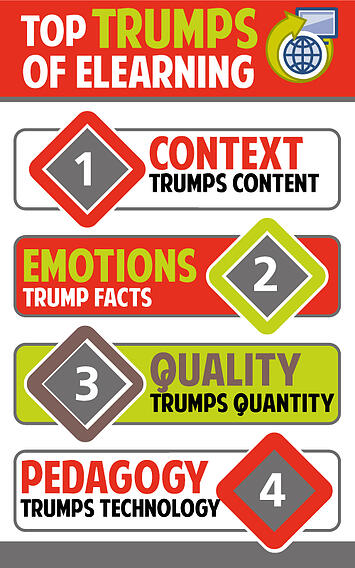What works better is usually obvious. But we as humans fall for what’s easy and what’s readily available. This is especially true when it comes to designing learning materials. Course designers and developers continue doing what they’re doing because it’s convenient, not because it’s effective. Below are what we consider the four top trumps or elements that work better in eLearning.
 1) Context Trumps Content
1) Context Trumps Content
Content has always been considered as king in the information age. Educators and trainers who focus too much on content miss a crucial point. More information doesn’t translate to better learning. Expecting students to recall more information is a low-level learning goal that usually accomplishes nothing. The challenge is to move beyond this towards a higher level objective, that is, application, synthesis, analysis and evaluation.
It’s a lofty goal but definitely doable. And you can achieve it with the help of context, not more content in a vacuum. This demands a change in your mindset as a trainer or educator. Rather than assume the role of a sage on stage, you have to put yourself in your learner’s shoes.
Focusing on context demands that you make sense of content. What does all this information mean for your learners? How can they apply it in real life or solve actual problems with it?
2) Emotions Trump Facts
One of our biggest biases is that facts are always superior to emotions, that facts are more reliable and rational. Studies, however, have shown that emotion trumps facts when it comes to our ability to recall. Neuroscience has unlocked a key concept that everything the human brain learns is filtered through emotions. Try dumping a big chunk of information to someone depressed and see for yourself.
Knowing this, you can tap your learner’s emotion to help him or her succeed. To do this, ask yourself how to fit your material to the emotional narrative of your learner’s life. It’s all about the learner and the contents of his or her experience. Ignore your learners’ emotions and all your efforts will be futile.
3) Quality Trumps Quantity
Less is more applies to eLearning too. More content, more flashy technology, and more ideas stuffed into a single presentation is a sure recipe for disaster. What learners need most today is quality eLearning material that uses simple yet powerful mechanisms. Engaging and truly effective content does not need special effects.
Instead of drowning students in a sea of content, why not keep stick to one idea and help them understand it deeply? For complicated subjects or concepts, you can look for patterns and chunk related ideas for better results. Let learners focus on a simple “must-learn” content per screen and cut out the non-essentials. Be ruthless in weeding out content that doesn’t help meet their goals. This is what quality over quantity means. It may sound easy in theory, but not in practice.
4) Pedagogy Trumps Technology
A lot of people think that new technology will cure all problems related to learning. But there’s no such thing as a technological silver bullet. Your constant search for the next best thing in eLearning may even distract you from the real job. No learning management system or authoring software or collaboration tool can replace the skills and insights of an effective instructor.
Spend most of your budget on sophisticated technology such as fancy graphics and instructional software and hand them over to your faculty. That’s an expensive way to fail.
eLearning is about learning, period. It isn’t about technology. The tools you are using are only as good as how you use them. So drop the e from eLearning and focus on things that truly matters to you and your learners.
Do you have any other element to add to this list? Tell us!









